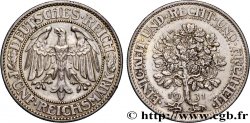fme_481039 - GERMANY - WEIMAR REPUBLIC Médaille de Bismarck et Hindenburg
Not available.
Item sold on our e-shop (2020)
Price : 150.00 €
Item sold on our e-shop (2020)
Price : 150.00 €
Type : Médaille de Bismarck et Hindenburg
Date: 1931
Mint name / Town : Allemagne
Metal : silver
Diameter : 36 mm
Orientation dies : 12 h.
Weight : 19,87 g.
Edge : inscrite : .BAYER. HAUPTMUNZAMT. FEINSILBER (traduction : Institut monétaire de Bavière. Argent pur)
Coments on the condition:
Aspect légèrement nettoyé. Présence de coups et rayures
Catalogue references :
Kienast457
Obverse
Obverse legend : REICHSGRVENDER // REICHSBESCHIRMER.
Obverse description : Bustes accolés à droite de Bismarck et d'Hindenburg; signé : K. GOETZ sur l’épaule.
Reverse
Reverse legend : 1871 / BISMARCK / HINDENBURG / 19 - 31 / 18 JANVAR.
Reverse description : Inscription sous une couronne et au dessus d’un aigle dans les flammes.
Commentary
Paul von Hindenburg est un militaire et homme d'État allemand né en 1847 et mort en 1934. Otto von Bismarck, duc de Lauenburg et prince de Bismarck, est un homme d'État prussien puis allemand né en 1815 et mort en 1898. Il sera premier chancelier du nouvel Empire allemand en 1871.
Par ailleurs la date du 18 janvier pourrait se rattacher à l’année 1871, date à laquelle l’empire allemand est proclamé dans la galerie des Glaces du château de Versailles. Le roi de Prusse se verra attribuer le titre d’empereur, sous le nom de Guillaume 1er. L’armistice entre la France et l’Allemagne sera signée 10 jours plus tard.
K. Goetz, de son nom entier, Karl Xaver Goetz, est un médailleur allemand né en 1875 et mort en 1950. Il réalisa des oeuvres de style Art Nouveau mais fut particulièrement connu pour sa série satyrique fabriqué pendant la première guerre mondiale et après (1913-1923). Puis, il créera des médailles dans le style néo-classique portraiturant des hommes politiques comme Paul von Hindenburg.
Par ailleurs la date du 18 janvier pourrait se rattacher à l’année 1871, date à laquelle l’empire allemand est proclamé dans la galerie des Glaces du château de Versailles. Le roi de Prusse se verra attribuer le titre d’empereur, sous le nom de Guillaume 1er. L’armistice entre la France et l’Allemagne sera signée 10 jours plus tard.
K. Goetz, de son nom entier, Karl Xaver Goetz, est un médailleur allemand né en 1875 et mort en 1950. Il réalisa des oeuvres de style Art Nouveau mais fut particulièrement connu pour sa série satyrique fabriqué pendant la première guerre mondiale et après (1913-1923). Puis, il créera des médailles dans le style néo-classique portraiturant des hommes politiques comme Paul von Hindenburg.








 Report a mistake
Report a mistake Print the page
Print the page Share my selection
Share my selection Ask a question
Ask a question Consign / sell
Consign / sell
 Full data
Full data


